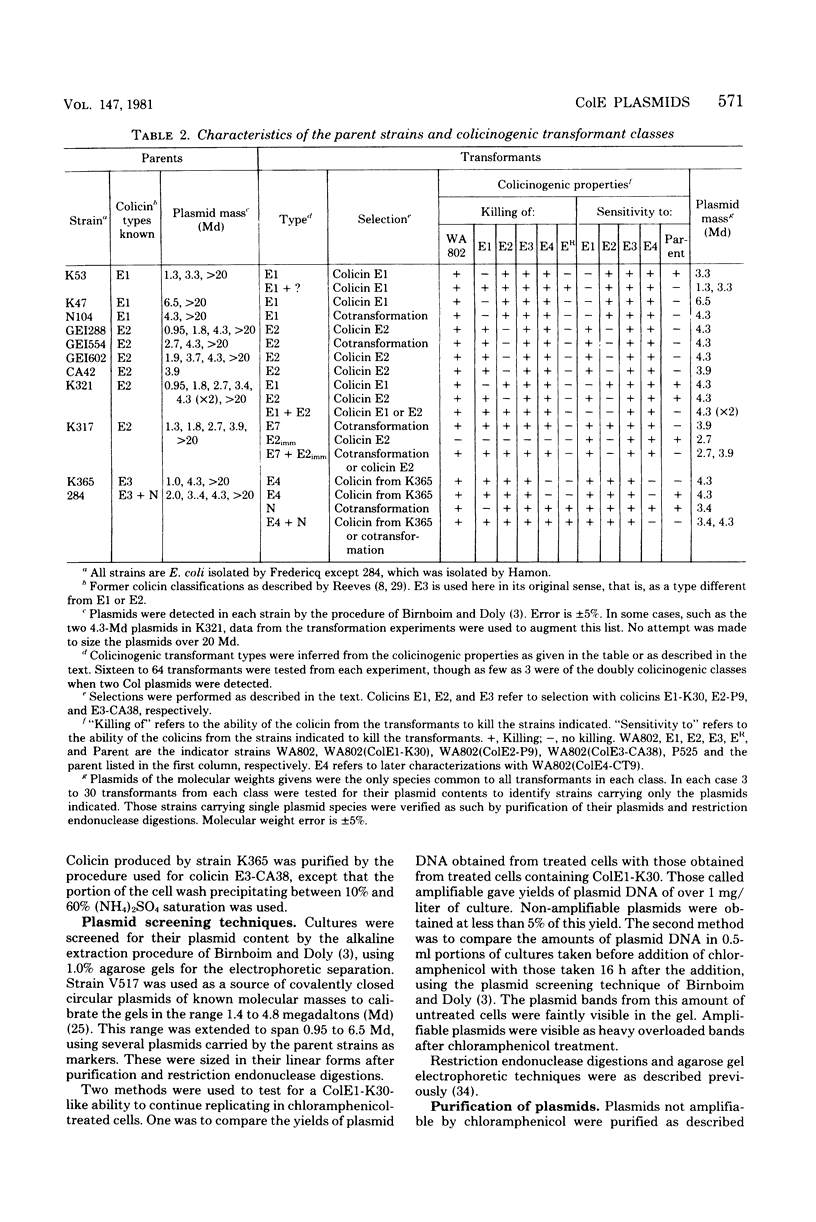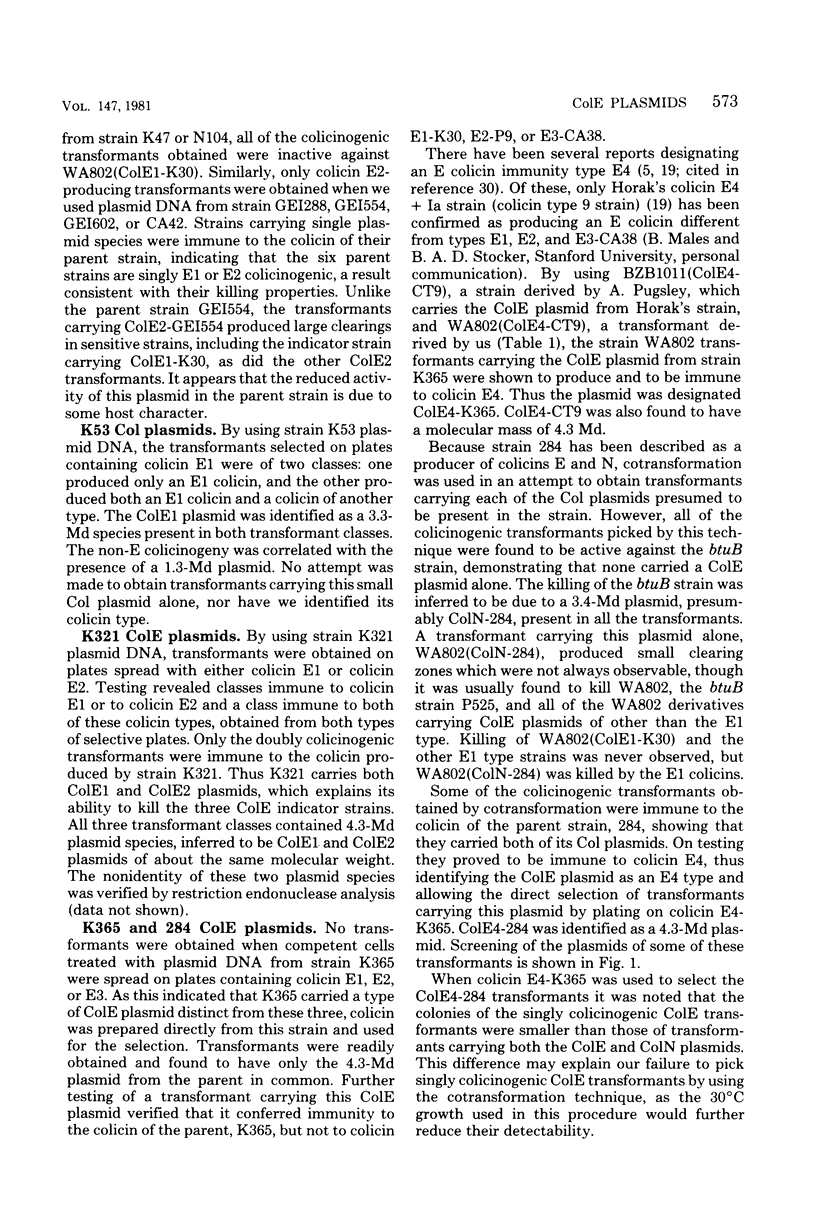Abstract
A series of transformants have been derived which carry the Col plasmids from 11 E-colicin-producing strains isolated by Fredericq or Hamon. The ColE plasmids identified included four of type E1, five of type E2, and two of a type designated E4 by Horak (Zentralbl. Bakteriol. Parasitenkd. Infektionskr. Hyg. Abt. 1 Orig. Reihe A 233:58-63, 1975). Strain K317 was shown to carry a ColE7 plasmid and a 2.7-megadalton (Md) ColE2imm plasmid which confers immunity to colicin E2 but not the ability to produce colicin. Other plasmids identified in the colicinogenic isolates were a 3.4-Md ColN plasmid and a 1.3-Md Col plasmid of unknown type. The ColE1 plasmids all continued replicating in cultures treated with chloramphenicol. Strains carrying the ColE4 or ColE3-CA38 plasmid exhibited partial sensitivity to their own colicins and exhibited an unusual clearing-zone morphology when overlaid on stabs of colicin E2- or E7-producing strains. Except for ColE1-K53, ColE1-K47, ColE2-CA42, and ColE7-K317, all of the ColE plasmids were found to be about 4.3 Md in size. ColE2-CA42 and ColE7-K317 are both about 3.9 Md and are the only two plasmids of the E2, E3, E4, and E7 types that did not yield a 0.39-Md deoxyribonucleic acid fragment as an EcoRI digestion product. The comparisons of the ColE plasmids suggest several structural and functional relationships among them.
Full text
PDF








Images in this article
Selected References
These references are in PubMed. This may not be the complete list of references from this article.
- Bachmann B. J., Low K. B. Linkage map of Escherichia coli K-12, edition 6. Microbiol Rev. 1980 Mar;44(1):1–56. doi: 10.1128/mr.44.1.1-56.1980. [DOI] [PMC free article] [PubMed] [Google Scholar]
- Betlach M., Hershfield V., Chow L., Brown W., Goodman H., Boyer H. W. A restriction endonuclease analysis of the bacterial plasmid controlling the ecoRI restriction and modification of DNA. Fed Proc. 1976 Jul;35(9):2037–2043. [PubMed] [Google Scholar]
- Birnboim H. C., Doly J. A rapid alkaline extraction procedure for screening recombinant plasmid DNA. Nucleic Acids Res. 1979 Nov 24;7(6):1513–1523. doi: 10.1093/nar/7.6.1513. [DOI] [PMC free article] [PubMed] [Google Scholar]
- Bolivar F., Rodriguez R. L., Greene P. J., Betlach M. C., Heyneker H. L., Boyer H. W., Crosa J. H., Falkow S. Construction and characterization of new cloning vehicles. II. A multipurpose cloning system. Gene. 1977;2(2):95–113. [PubMed] [Google Scholar]
- Cavard D., Lazdunski C. J. Purification and molecular properties of a new colicin. Eur J Biochem. 1979 Jun 1;96(3):519–524. doi: 10.1111/j.1432-1033.1979.tb13065.x. [DOI] [PubMed] [Google Scholar]
- Clewell D. B., Helinski D. R. Effect of growth conditions on the formation of the relaxation complex of supercoiled ColE1 deoxyribonucleic acid and protein in Escherichia coli. J Bacteriol. 1972 Jun;110(3):1135–1146. doi: 10.1128/jb.110.3.1135-1146.1972. [DOI] [PMC free article] [PubMed] [Google Scholar]
- Dagert M., Ehrlich S. D. Prolonged incubation in calcium chloride improves the competence of Escherichia coli cells. Gene. 1979 May;6(1):23–28. doi: 10.1016/0378-1119(79)90082-9. [DOI] [PubMed] [Google Scholar]
- Elgat M., Ben-Gurion R. Mode of action of pesticin. J Bacteriol. 1969 May;98(2):359–367. doi: 10.1128/jb.98.2.359-367.1969. [DOI] [PMC free article] [PubMed] [Google Scholar]
- FREDERICQ P. Colicins and colicinogenic factors. Symp Soc Exp Biol. 1958;12:104–122. [PubMed] [Google Scholar]
- FREDERICQ P. Résistance et immunité aux colicines. C R Seances Soc Biol Fil. 1956;150(7):1514–1517. [PubMed] [Google Scholar]
- Guerry P., LeBlanc D. J., Falkow S. General method for the isolation of plasmid deoxyribonucleic acid. J Bacteriol. 1973 Nov;116(2):1064–1066. doi: 10.1128/jb.116.2.1064-1066.1973. [DOI] [PMC free article] [PubMed] [Google Scholar]
- HAMON Y., PERON Y. A PROPOS DE QUELQUES NOUVEAUX TYPES DE COLICINES THERMOSTABLES. C R Hebd Seances Acad Sci. 1964 Mar 16;258:3121–3124. [PubMed] [Google Scholar]
- Herschman H. R., Helinski D. R. Comparative study of the events associated with colicin induction. J Bacteriol. 1967 Sep;94(3):691–699. doi: 10.1128/jb.94.3.691-699.1967. [DOI] [PMC free article] [PubMed] [Google Scholar]
- Herschman H. R., Helinski D. R. Purification and characterization of colicin E2 and colicin E3. J Biol Chem. 1967 Nov 25;242(22):5360–5368. [PubMed] [Google Scholar]
- Horák V. Typing of Shigella sonnei colicins by means of specific indicators. Zentralbl Bakteriol Orig A. 1975 Sep;233(1):58–63. [PubMed] [Google Scholar]
- Hughes V., Le Grice S., Hughes C., Meynell G. G. Two major groups of colicin factors: their molecular weights. Mol Gen Genet. 1978 Feb 16;159(2):219–221. doi: 10.1007/BF00270897. [DOI] [PubMed] [Google Scholar]
- Inselburg J. Incompatibility exhibited by colicin plasmids E1, E2, and E3 in Escherichia coli. J Bacteriol. 1974 Aug;119(2):478–483. doi: 10.1128/jb.119.2.478-483.1974. [DOI] [PMC free article] [PubMed] [Google Scholar]
- Inselburg J., Johns V. Mapping of colicin E2 and colicin E3 plasmid deoxyribonucleic acid EcoR-1-sensitive sites. J Bacteriol. 1975 Jan;121(1):381–389. doi: 10.1128/jb.121.1.381-389.1975. [DOI] [PMC free article] [PubMed] [Google Scholar]
- KASATYIA S., HAMON Y. ETUDE DU POUVOIR COLICINOG'ENE PARMI LES "E. COLI" O 119 : B 14. Rev Hyg Med Soc. 1965 Jan-Feb;13:35–48. [PubMed] [Google Scholar]
- Macrina F. L., Kopecko D. J., Jones K. R., Ayers D. J., McCowen S. M. A multiple plasmid-containing Escherichia coli strain: convenient source of size reference plasmid molecules. Plasmid. 1978 Jun;1(3):417–420. doi: 10.1016/0147-619x(78)90056-2. [DOI] [PubMed] [Google Scholar]
- Males B. M., Stocker B. A. Escherichia coli K317, formerly used to define colicin group E2, produces colicin E7, is immune to colicin E2, and carries a bacteriophage-restricting conjugative plasmid. J Bacteriol. 1980 Nov;144(2):524–531. doi: 10.1128/jb.144.2.524-531.1980. [DOI] [PMC free article] [PubMed] [Google Scholar]
- Reeves P. Mode of action of colicins of types E1, E2, E3, and K. J Bacteriol. 1968 Nov;96(5):1700–1703. doi: 10.1128/jb.96.5.1700-1703.1968. [DOI] [PMC free article] [PubMed] [Google Scholar]
- Reeves P. Mutants resistant to colicin CA42-E2: cross resistance and genetic mapping of a special class of mutants. Aust J Exp Biol Med Sci. 1966 Jun;44(3):301–315. doi: 10.1038/icb.1966.29. [DOI] [PubMed] [Google Scholar]
- Reynolds B. L., Reeves P. R. Kinetics of adsorption of colicin CA42-E2 and reversal of its bactericidal activity. J Bacteriol. 1969 Oct;100(1):301–309. doi: 10.1128/jb.100.1.301-309.1969. [DOI] [PMC free article] [PubMed] [Google Scholar]
- Schaller K., Nomura M. Colicin E2 is DNA endonuclease. Proc Natl Acad Sci U S A. 1976 Nov;73(11):3989–3993. doi: 10.1073/pnas.73.11.3989. [DOI] [PMC free article] [PubMed] [Google Scholar]
- Schwartz S. A., Helinski D. R. Purification and characterization of colicin E1. J Biol Chem. 1971 Oct 25;246(20):6318–6327. [PubMed] [Google Scholar]
- Smith H. R., Humphreys G. O., Willshaw G. A., Anderson E. S. Characterisation of plasmids coding for the restriction endonuclease EcoRI. Mol Gen Genet. 1976 Feb 2;143(3):319–325. doi: 10.1007/BF00269410. [DOI] [PubMed] [Google Scholar]
- Watson R., Visentin L. P. Restriction endonuclease mapping of ColE2-P9 and ColE3-CA38 plasmids. Gene. 1980 Sep;10(4):307–318. doi: 10.1016/0378-1119(80)90151-1. [DOI] [PubMed] [Google Scholar]
- Wood W. B. Host specificity of DNA produced by Escherichia coli: bacterial mutations affecting the restriction and modification of DNA. J Mol Biol. 1966 Mar;16(1):118–133. doi: 10.1016/s0022-2836(66)80267-x. [DOI] [PubMed] [Google Scholar]




